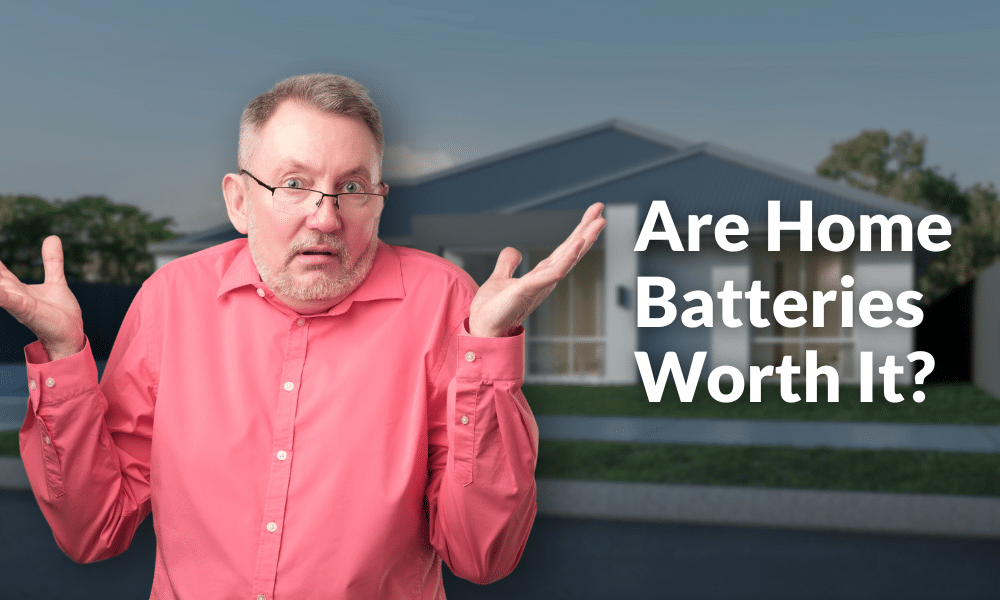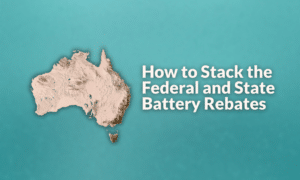Once thought of as a gimmick, home battery storage is now the hot ticket item, and some installers are finding that their stocks are beginning to dwindle as their popularity soars. Many are claiming that the federal Cheaper Home Batteries program was the winning ticket that got Anthony Albanese and the Labor Party over the line. It’s not hard to see why – Aussies are fed up with paying through the nose for electricity and want to take back some control over their expenses.
With the federal rebate gearing up for 1 July, and some state rebates and incentives allowing for stacking, how much can you really save, and are batteries really all they’re hyped up to be?
Back in the good old days of solar
When solar systems were the ‘gimmick’ and the federal government dished out rebates like hot cakes, you could install a small solar system for a few thousand and get a feed-in tariff (FiT) at a rate of around 60c/kWh. Imagine a 3kW solar system in VIC producing around 10-12 kWh a day (adjusted for panel efficiency in 2009), using a third of it, and exporting the rest to the grid. You would be making around $5 a day from your solar. Electricity prices were around 17-20c/kWh, and you’d be saving more with your solar than what you were using. The average Victorian family in 2009, with a 3kW solar system and a FiT of 60c would be about $625 in credit at the end of the year.
Those days are gone.
To put it in perspective, I live in Victoria and have a 7.9kW solar system. We recently changed retailers, so our new FiT is 6c/kWh (previously 3.3c), and our base electricity rate is 29c/kWh. Without solar, a family of 5 in Victoria with my setup would expect to pay around $2,131.79/year for electricity. With solar, you can expect to pay $556.25/year. Massive savings! But not in the green like yesteryear.
How does battery storage work?
This is where batteries step in.
Batteries can store all the unused solar energy. At night time, or during overcast days or blackouts, your battery will discharge the energy stored for use around your home. Instead of paying 29c/kWh, which is what I’m paying when not using solar, I would be paying zilch. My bills could effectively be $0. This is where things get even better: I could use a platform like Amber Energy to sell my stored energy during peak times. You can even top up your battery with electricity from the grid during off-peak hours and sell it during peak hours. The glory days of 2009 could be popping up again.
Battery return on investment evaluation
Now, it’s one thing to talk about savings, but factoring in the cost of the battery is vital to truly evaluate the cost-benefit of installing one.
Let’s break it down.
Using the example of a family of 5 in Victoria with an annual electricity bill of $2,131.79. After the Victorian solar rebate, a 7.9kW solar system would set you back around $3,648–$6,648. With the Solar Homes Program interest-free loan, the upfront cost drops to $2,248–$5,248. Taking the average without the loan — $5,148 — and assuming electricity costs drop to $556.25/year, that’s an annual saving of $1,575.54. The ROI for the solar system is just over 3 years.
Now let’s look at adding a 16kWh battery.
A 16kWh battery with installation in Victoria would typically cost $13,000–$16,000 before rebates. After applying the federal battery rebate of up to $5,952, your out-of-pocket cost drops to around $7,048–$10,048. There’s no Victorian battery rebate at present, and Solar Victoria has closed applications for this financial year’s interest-free battery loan.
When evaluating battery ROI, we exclude solar savings (which have their own ROI). A 16kWh battery could save an additional $1,300–$1,800 per year by increasing solar self-consumption and reducing grid reliance.
That puts the battery payback period between 4 and 8 years, depending on installation cost and energy usage.
And that’s before you factor in possible income from Virtual Power Plants (VPPs) or wholesale energy trading with platforms like Amber Energy. Those could bring your ROI down even further. Some home battery owners are making hundreds of dollars every week by selling their stored electricity during peak times – some have even made $1k in a day. But that’s information for another blog!
Is a home battery worth it?
The simplest answer is yes.
Batteries typically come with warranty periods of 10 years. This means that your battery is guaranteed to perform as specified for that time frame (usually around 70% of day 1 capacity). If the ROI is between 4 and 8 years, you will still have 2 to 6 years of optimal usage after you have seen that return on investment. Let’s face it, we know that batteries last longer than 10 years, even if they don’t discharge at the same level as before. So you could be looking at a total of 12 to 15+ years with your battery, depending on how you use it.
If you’re installing a brand new solar system with your battery, you can expect an ROI for both between 3 and 6 years. We see this as a solid investment. You may live in a state that offers a battery rebate that is stackable – this will see the ROI reduced again.
As Australia wisens up to its current and future energy landscape, taking hold of your energy independence has never been more important. Don’t let electricity rate fluctuations impact your home any longer – take advantage of the federal rebate while it exists, and while it is at its maximum (it will reduce next year). Get FREE quotes today and take control of your electricity usage and generation.
All figures are based on averages and factor in low to high quality system prices available in Victoria in 2025. All figures are for educational purposes and should be used as a guide only.
















































